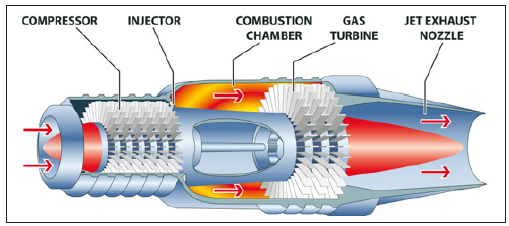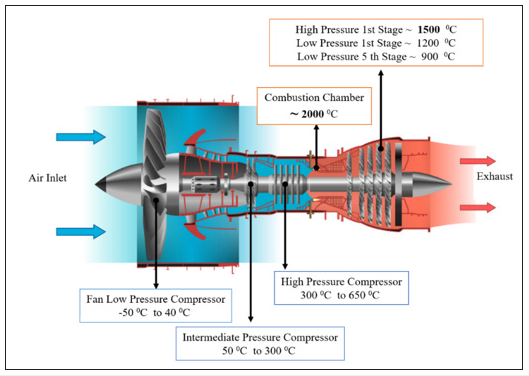- Submissions

Full Text
Evolutions in Mechanical Engineering
The Temperature and Material Distribution Inside a Gas Turbine Engine
Tamer Saraçyakupoğlu*
Department of Aeronautical Engineering, Istanbul Gelisim University, Turkey
*Corresponding author:Tamer Saraçyakupoğlu, Department of Aeronautical Engineering, Istanbul Gelisim University, Istanbul, Turkey
Submission: October 25, 2021;Published: January 26, 2022

ISSN 2640-9690 Volume4 Issue1
Mini Review
The propulsion for the air vehicles is generated by the power obtained from the engines. Especially during take-off and climb phases, the air vehicles need the maximum power. Mainly, as presented in Figure 1, it is possible to handle the flight stages in 8 sections, 2 of which are runway maneuvers (Taxi). The cruise phase begins immediately after the climb phase is completed. In this stage, the fuel consumption is less than take-off and climb phases. Although it depends on the aircraft configuration and meteorological conditions, the descent phase, which usually takes place with a 3° nose angle, is one of the most critical stages. In this phase, the use of fuel is less than that of the cruise.
Figure 1:Flight phases [1].

It is noteworthy that, a Boeing 777-300ER consumes 50 liters of fuel in every two 22 seconds depending on meteorological conditions and payload through an intercontinental flight [2]. Considering that the tank of a middle-class passenger car has a capacity of 40-50 liters, it can be observed that the mentioned aircraft consumes approximately as much as the fuel in the tank of 3 mid-class cars per minute. Engines with such high fuel consumption are also designed with advanced engineering studies like air vehicle platforms and can be implemented to an aircraft after meticulous inspections performed by the airworthiness authorities [3,4].
Converting altitude to speed is also a method of acceleration however except for the meteorological conditions (Tail Wind), the propulsion system is considered as the heart of the aircraft since power is the only way to gain speed in the air. In Figure 2 the main modules of the gas turbine engine are illustrated. The material distribution is extremely important in a gas turbine engine consisting of more than 30,000 parts [5]. Considering that there is approximately 2000 °C, in the combustion chamber and approximately 00 °C, in the parts of the turbine “gas turbine” close to the combustion chamber, the importance of operating for a long time without deteriorating the properties of the materials used in the engine becomes noteworthy. These temperatures are higher than the lava from the volcano. The temperature of lava coming out of Erta’Ale Lava Lake volcano in Ethiopia was measured as 1187 °C [6], and the temperature of lava coming out of Kilauea volcano in Hawaii was measured as 1230 °C [7]. In Figure 3, the temperature distribution in a gas turbine engine is shown.
Figure 2:The main sections of a gas turbine engine [(Based on Author’s Knowledge)].

Figure 3: The sections and temperatures distribution inside a GTE [8].

In this manner, Thermal Barrier Coating (TBC) is a technology used to keep the high heat generated on the surface away from the body of the part [9]. However, even if TBC is used, the desired strength of gas turbine engine parts operating in a high temperature and high friction environment can only be possible by alloying. The mentioned alloying and manufacturing method is presented in Table 1.
Table 1:The manufacturing technologies and alloys of the parts used in a GTE [10-12].

Conclusion
Conclusion, a GTE operates under excessive environmental conditions. Therefore, manufacturing a part of assembling a component requires advanced aviation Technologies. In this manner, it can be easily claimed that the manufacturing of a gas turbine engine is only possible with the collaborative study of many engineering disciplines such as aeronautical, materials, mechanical, and mechatronics.
References
- Saraçyakupoglu T (2020) Emniyet Irtifasindan bilgiler: genel havacilik, üretim ve bakim süreç Nobel Academic Publishing, Ankara, Turkey.
- Çakici M (2019) Havada kalan sorular. Efil Yayinevi, Ankara, Turkey.
- Saraçyakupoglu T (2021) Fracture and failure analysis of the trainer aircraft rudder pedal hanger. Engineering Failure Analysis 122: 105254.
- Saraçyakupoglu T (2020) Havacilikta organizasyonel kazalar: B-737 max uçak kazalarinin mühendislik perspektifinden incelenmesi . Mühendis ve Makina, 61(701): 241-261.
- Spittle P (2003) Gas turbine technology. Physics Education 38: 504-511.
- Burgi YP, Caillet M, Haefeli S (2002) Field temperature measurements at Erta'Ale Lava Lake, Ethiopia. Bulletin of Volcanology 64: 472-485.
- Radebaugh GT, Saito JT, Lorenz RD, Dangerfield A, Tingey DG, et al. (2015) Temperatures, thermal structure, and behavior of eruptions at Kilauea and Erta Ale volcanoes using a consumer digital camcorder. Geo Res J 47-57.
- Saraçyakupoglu T (2021) “Novel manufacturing techniques of the airborne parts” in “Theory and Research in Engineering-II”, Gece Publishing, Ankara, Turkey.
- Saraçyakupoglu T (2020) Uçusa elverislilik kural ve düzenlemelerine göre, havacilik endüstrisinde 3 boyutlu üretim uygulamalari. International Journal of 3D Printing Technologies and Digital Industry 4 (1): 53-65.
- Peter S (2003) Gas turbine technology. Physics Education 38(6): 504-511.
- Mitsuhiro T, Masashi K (2014) Making lighter aircraft engines with titanium aluminide blades. IHI Engineering Review 47(1): 10-13.
- Saraçyakupoglu T (2021) Bir gaz türbin motoru kompresör Palesininti6al4v alasimindan eklemeli üretim yöntemi ile imalati ve boyutsal dogrulamasi. Mühendis ve Makina 62(702): 151-179.
© 2022 Tamer Saraçyakupoğlu. This is an open access article distributed under the terms of the Creative Commons Attribution License , which permits unrestricted use, distribution, and build upon your work non-commercially.
 a Creative Commons Attribution 4.0 International License. Based on a work at www.crimsonpublishers.com.
Best viewed in
a Creative Commons Attribution 4.0 International License. Based on a work at www.crimsonpublishers.com.
Best viewed in 







.jpg)






























 Editorial Board Registrations
Editorial Board Registrations Submit your Article
Submit your Article Refer a Friend
Refer a Friend Advertise With Us
Advertise With Us
.jpg)






.jpg)














.bmp)
.jpg)
.png)
.jpg)










.jpg)






.png)

.png)



.png)






